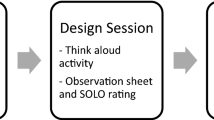Abstract
This study investigated interactions between the isolated–interactive elements effect and levels of learner expertise with first year undergraduate university accounting students. The isolated–interactive elements effect occurs when learning is facilitated by initially presenting elements of information sequentially in an isolated form rather than in a fully interactive form. The expertise reversal effect occurs when the relevant advantage of one instructional technique over another reverses depending on the learner’s level of expertise. The results provided support for the predicted interaction with lower expertise students benefitting from the isolated elements instructional method, while students with more expertise learned more from the interacting elements format.



Similar content being viewed by others
References
Clarke, T., Ayres, P., & Sweller, J. (2005). The impact of sequencing and prior knowledge on learning mathematics through spreadsheet applications. Educational Technology Research and Development, 53, 15–24.
Gerjets, P., Scheiter, K., & Catrambone, R. (2006). Can learning from molar and modular worked examples be enhanced by providing instructional explanations and prompting self-explanations? Learning and Instruction, 16, 104–121.
Ginns, P., Chandler, P., & Sweller, J. (2003). When imagining information is effective. Contemporary Educational Psychology, 28, 229–251.
Kalyuga, S. (2007). Expertise reversal effect and its implications for learner-tailored instruction. Educational Psychology Review, 19, 509–539.
Kalyuga, S., Ayres, P., Chandler, P., & Sweller, J. (2003). The expertise reversal effect. Educational Psychologist, 38, 23–31.
Kalyuga, S., & Sweller, J. (2004). Measuring knowledge to optimize cognitive load factors during instruction. Journal of Educational Psychology, 96, 558–568.
Kirschner, P., Sweller, J., & Clark, R. (2006). Why minimal guidance during instruction does not work: An analysis of the failure of constructivist, discovery, problem-based, experiential and inquiry-based teaching. Educational Psychologist, 41, 75–86.
Kruck, S. (2006). Testing spreadsheet accuracy theory. Information and Software Technology, 48, 204–221.
Mayer, R. E., Mathias, S., & Wetzell, K. (2002). Fostering understanding of multimedia messages through pretraining: Evidence for a two-stage theory of mental model construction. Journal of Experimental Psychology: Applied, 8, 147–154.
Pollock, E., Chandler, P., & Sweller, J. (2002). Assimilating complex information. Learning and Instruction, 12, 61–86.
Powell, S., Baker, K., & Lawson, B. (2008). An auditing protocol for spreadsheet models. Information & Management, 45, 312–320.
Reisslein, J., Atkinson, R., Seeling, P., & Reisslein, M. (2006). Encountering the expertise reversal effect with a computer-based environment on electrical circuit analysis. Learning and Instruction, 16, 92–103.
Renkl, A., & Atkinson, R. K. (2003). Structuring the transition from example study to problem solving in cognitive skills acquisition: A cognitive load perspective. Educational Psychologist, 38, 15–22.
Scheiter, K., & Gerjets, P. (2007). Making your own order: Order effects in system- and user-controlled settings for learning and problem solving. In F. Ritter, J. Nerb, E. Lehtinen, & T. O’Shea (Eds.), In order to learn: How the sequence of topics influences learning (pp. 195–212). New York: Oxford University Press.
Sweller, J. (1994). Cognitive load theory, learning difficulty, and instructional design. Learning and Instruction, 4, 295–312.
Sweller, J. (2003). Evolution of human cognitive architecture. In B. Ross (Ed.), The psychology of learning and motivation (Vol. 43, pp. 215–266). San Diego: Academic Press.
Sweller, J. (2004). Instructional design consequences of an analogy between evolution by natural selection and human cognitive architecture. Instructional Science, 32, 9–31.
Sweller, J., & Sweller, S. (2006). Natural information processing systems. Evolutionary Psychology, 4, 434–458.
Van Merriënboer, J. J. G. (1997). Training complex cognitive skills: A four-component instructional design model for technical training. Englewood Cliffs: Educational Technology Publications.
Author information
Authors and Affiliations
Corresponding author
Rights and permissions
About this article
Cite this article
Blayney, P., Kalyuga, S. & Sweller, J. Interactions between the isolated–interactive elements effect and levels of learner expertise: experimental evidence from an accountancy class. Instr Sci 38, 277–287 (2010). https://doi.org/10.1007/s11251-009-9105-x
Received:
Accepted:
Published:
Issue Date:
DOI: https://doi.org/10.1007/s11251-009-9105-x




